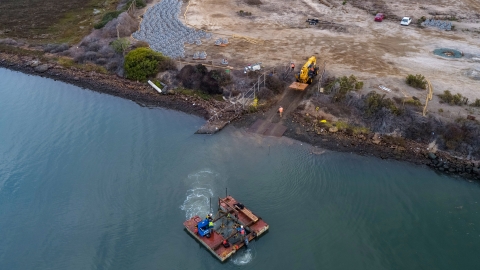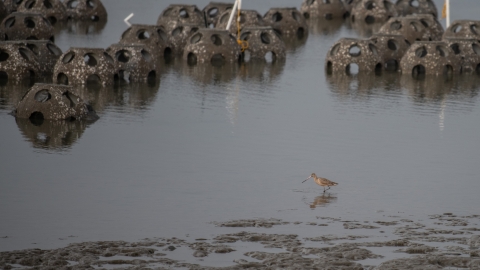Taking advantage of one of our 2021 National Coastal Wetlands Conservation Grants, the Port of San Diego, in partnership with the California State Coastal Conservancy and the Service, is building a native oyster reef in San Diego Bay next to Chula Vista Wildlife Reserve, which is managed by the Port of San Diego.
Workers are putting in the bay more than 300 “reef balls,” round objects made of baycrete, concrete mixed with local sand and oyster shell aggregate. This new reef habitat should attract native Olympia oysters. They would then reproduce, and their offspring would find a spot on the reef.
In this way, oyster reefs provide an excellent resiliency defense to sea level rise because they adapt and grow over time. Traditional hard armoring, such as riprap and sea walls, often fall short and are environmentally damaging.
“The Port of San Diego is proactively and continuously planning for and implementing various strategies to reduce the impacts of future sea level rise,” says Michael Zucchet, chairman of the Port of San Diego Board of Port Commissioners.
This reef is known as a living shoreline, which relies on natural elements to stabilize shorelines. Other benefits to this approach can include:
- Buffering the area from strong waves and flooding
- Limiting erosion
- Providing habitat and food not just for oysters but also for other marine wildlife and birds
- Increasing wetland connectivity
Oysters also improve local water quality via water filtration. “A single adult oyster can filter more than 50 gallons of water a day,” according to the National Oceanic and Atmospheric Administration.
“This project demonstrates the potential of nature-based solutions to help one of California’s most iconic and vibrant waterfronts keep pace with rising seas,” says Amy Hutzel, executive officer of the California State Coastal Conservancy.
“National Coastal Wetlands Conservation grants issued by the U.S. Fish and Wildlife Service’s Sport Fish Restoration Fund are made available through recreational fishing taxes,” says Scott Sobiech, field supervisor of our Carlsbad Fish and Wildlife Office. “We in turn want to thank our angling and boating partners for their contributions to wetlands conservation.”
Zucchet calls this an important project “that will strengthen coastal resiliency along our waterfront while also helping to protect and enhance the diverse ecosystems in and around San Diego Bay.”
Federally protected species this project should help include California least terns and green sea turtles found in neighboring habitats.
We are glad to help. As Sobiech says, “The Carlsbad Fish and Wildlife Office’s Coastal Program is excited to be partnering with the Port of San Diego and California State Coastal Conservancy to protect and enhance San Diego Bay’s shoreline, which is critical to wildlife and the coastal community.”






